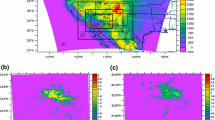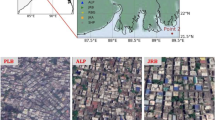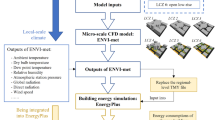Abstract
An urban heat island (UHI) is a phenomenon where the temperatures within cities are greater than those of surrounding rural areas due to human activity and physical properties of urban surfaces. One method that has been investigated as a way to mitigate the UHI phenomenon is to increase the surface albedo in cities, which reflects a greater amount of solar radiation away from these surfaces compared to conventional materials (e.g., dark asphalt shingles). In this study, we utilize the Weather Research and Forecasting (WRF) model to investigate the UHI under different scenarios during a July 2012 heat wave event in the Kansas City metropolitan area (KCMA). Two cool roof simulations are implemented to determine the effectiveness of this mitigation strategy on reducing temperatures within the KCMA. The first scenario represents “newly installed” cool roofs with an albedo of 0.8 and the second with “aged” cool roofs with an albedo of 0.5. Results indicate that cool roof materials were able to mitigate the UHI effect by up to 0.64 °C during the evening, causing the onset of the UHI effect to be delayed until later in the day. Cool roofs were also shown to have important impacts on the surface energy balance, affecting both sensible and ground storage heat fluxes, and the planetary boundary layer.











Similar content being viewed by others
Availability of data and material
The datasets generated during and/or analyzed during the current study are available from the corresponding authors upon reasonable request.
Code availability
Code for the Weather Research and Forecasting model version 3.9.1.1 is available at https://www2.mmm.ucar.edu/wrf/users/download/get_source.html.
References
Akbari H, Behre AA, Levinson R, Graveline S, Foley K, Delgado AH, Paroli RM (2005) Aging and weathering of cool roofing membranes. United States. https://www.osti.gov/servlets/purl/860745
Bretz SE, Akbari H (1997) Long-term performance of high-albedo roof coatings. Energy Build 25:159–167. https://doi.org/10.1016/s0378-7788(96)01005-5
Cao M, Rosado P, Lin Z et al (2015) Cool roofs in guangzhou, china: outdoor air temperature reductions during heat waves and typical summer conditions. Environ Sci Technol 49:14672–14679. https://doi.org/10.1021/acs.est.5b04886
Chen Y, Zhang N (2018) Urban heat island mitigation effectiveness under extreme heat conditions in the Suzhou-Wuxi-Changzhou Metropolitan area, China. J Appl Meteorol Climatol 57:235–253. https://doi.org/10.1175/JAMC-D-17-0101.1
Chen F, Kusaka H, Bornstein R et al (2011) The integrated WRF/urban modelling system: development, evaluation, and applications to urban environmental problems. Int J Climatol 31:273–288. https://doi.org/10.1002/joc.2158
EPA (2006) Excessive heat events guidebook. https://www.epa.gov/sites/production/files/2016-03/documents/eheguide_final.pdf. Accessed 15 Jul 2021
Epstein SA, Lee SM, Katzenstein AS et al (2017) Air-quality implications of widespread adoption of cool roofs on ozone and particulate matter in southern California. Proc Natl Acad Sci USA 114:8991–8996. https://doi.org/10.1073/pnas.1703560114
Giannaros TM, Melas D, Daglis IA et al (2013) Numerical study of the urban heat island over Athens (Greece) with the WRF model. Atmos Environ 73:103–111. https://doi.org/10.1016/j.atmosenv.2013.02.055
Hafner J, Kidder SQ (1999) Urban heat island modeling in conjunction with satellite-derived surface/soil parameters. J Appl Meteorol 38:448–465. https://doi.org/10.1175/1520-0450
Heaviside C, Vardoulakis S, Cai XM (2016) Attribution of mortality to the urban heat island during heatwaves in the West Midlands, UK. Environ Heal A Glob Access Sci Sourc 15:49–59. https://doi.org/10.1186/s12940-016-0100-9
Hoerling M, Eischeid J, Kumar A et al (2014) Causes and predictability of the 2012 Great Plains drought. Bull Am Meteorol Soc 95:269–282. https://doi.org/10.1175/BAMS-D-13-00055.1
Hoffman JS, Shandas V, Pendleton N (2020) The effects of historical housing policies on resident urban areas. Climate 8:1–15. https://doi.org/10.3390/cli8010012
Homer CG, Dewitz J, Yang L et al (2015) Completion of the 2011 National Land Cover Database for the conterminous United States—representing a decade of land cover change information. Photogramm Eng Rem Sens 81:345–353. https://doi.org/10.14358/PERS.81.5.345
Imran HM, Kala J, Ng AW, Muthukumaran S (2018) Effectiveness of green and cool roofs in mitigating urban heat island effects during a heatwave event in the city of Melbourne in southeast Australia. J Clean Prod 197:393–405. https://doi.org/10.1016/j.jclepro.2018.06.179
Jenerette GD, Harlan SL, Stefanov WL et al (2011) Ecosystem services and urban heat riskscape moderation: water, green spaces, and social inequality in Phoenix, USA. Ecol Soc Am 21:2637–2651. https://doi.org/10.1890/10-1493.1
Jeong S, Millstein D, Levinson R (2021) Modeling potential air temperature reductions yielded by cool roofs and urban irrigation in the Kansas City Metropolitan Area. Urban Clim 37:1–10. https://doi.org/10.1016/j.uclim.2021.100833
Jesdale BM, Morello-Frosch R, Cushing L (2013) The racial/ethnic distribution of heat risk-related land cover in relation to residential segregation. Environ Health Perspect 121:811–817. https://doi.org/10.1289/ehp.1205919
Jeworrek J, West G, Stull R (2019) Evaluation of cumulus and microphysics parameterizations in WRF across the convective gray zone. Weather Forecast 34:1097–1115. https://doi.org/10.1175/WAF-D-18-0178.1
Kaiser D, Köhler M, Schmidt M, Wolff F (2019) Increasing evapotranspiration on extensive green roofs by changing substrate depths, construction, and additional irrigation. Buildings 9:173. https://doi.org/10.3390/buildings9070173
Kim YH, Baik JJ (2005) Spatial and Temporal Structure of the Urban Heat Island in Seoul. J Appl Meteorol 44:591–605. https://doi.org/10.1175/JAM2226.1
Kusaka H, Kimura F (2004) Coupling a single-layer urban canopy model with a simple atmospheric model : impact on urban heat island simulation for an idealized case coupling a single-layer urban canopy model with a simple atmospheric model: impact on urban heat Island simulation f. J Meteorol Soc Japan 82:67–80. https://doi.org/10.2151/jmsj.82.67
Kusaka H, Kondo H, Kikegawa Y, Kimura F (2001) A simple single-layer urban canopy model for atmospheric models: comparison with multi-layer and slab models. Bound-Layer Meteorol 101:329–358. https://doi.org/10.1023/A:1019207923078
Laaidi K, Zeghnoun A, Bretin P et al (2012) The Impact of heat Islands on mortality in Paris during the August 2003 Heat Wave. Environ Health Perspect 120:254–259. https://doi.org/10.1289/ehp.1103532
Li D, Bou-Zeid E, Oppenheimer M (2014) The effectiveness of cool and green roofs as urban heat island mitigation strategies. Environ Res Lett 9:16. https://doi.org/10.1088/1748-9326/9/5/055002
Ma S, Pitman A, Yang J et al (2018) Evaluating the effectiveness of mitigation options on heat stress for Sydney, Australia. J Appl Meteorol Climatol 57:209–220. https://doi.org/10.1175/JAMC-D-17-0061.1
Memon RA, Leung DYC, Liu CH (2009) An investigation of urban heat island intensity (UHII) as an indicator of urban heating. Atmos Res 94:491–500. https://doi.org/10.1016/j.atmosres.2009.07.006
Mesinger F, Dimego G, Kalnay E et al (2005) North American regional reanalysis. Bull Am Meteorol Soc 87:343–360. https://doi.org/10.1175/BAMS-87-3-343
Morini E, Touchaei AG, Castellani B et al (2016) The impact of albedo increase to mitigate the urban heat island in Terni (Italy) using the WRF model. Sustain 8:1–14. https://doi.org/10.3390/su8100999
Morini E, Touchaei AG, Rossi F et al (2018) Evaluation of albedo enhancement to mitigate impacts of urban heat island in Rome (Italy) using WRF meteorological model. Urban Clim 24:551–566. https://doi.org/10.1016/j.uclim.2017.08.001
Murage P, Hajat S, Kovats RS (2017) Effect of night-time temperatures on cause and age-specific mortality in London. Environ Epidemiol 1:1–7. https://doi.org/10.1097/ee9.0000000000000005
Nehrkorn T, Henderson J, Leidner M et al (2013) WRF simulations of the urban circulation in the Salt Lake City area for CO2 modeling. J Appl Meteorol Climatol 52:323–340. https://doi.org/10.1175/JAMC-D-12-061.1
Oke TR (1982) The energetic basis of the urban heat island. Q J R Meteorol Soc 108:1–24. https://doi.org/10.1002/qj.49710845502
Oke TR, Mills G, Christen A, Voogt JA (2017) Urban climates. Cambridge University Press, New York
Peterson TC, Hoerling MP, Stott PA, Herring S (2013) Explaining extreme events of 2012 from a climate perspective. Bull Am Meteorol Soc 94:S1–S74. https://doi.org/10.1175/BAMS-D-13-00085.1
Robine JM, Cheung SLK, Le Roy S et al (2008) Death toll exceeded 70,000 in Europe during the summer of 2003. Comptes Rend Biol 331:171–178. https://doi.org/10.1016/j.crvi.2007.12.001
Salamanca F, Georgescu M, Mahalov A et al (2014) Anthropogenic heating of the urban environment due to air conditioning. J Geophys Res Atmos 119:5949–5965. https://doi.org/10.1002/2013JD021225.Received
Salamanca F, Georgescu M, Mahalov A et al (2016) Citywide impacts of cool roof and rooftop solar photovoltaic deployment on near-surface air temperature and cooling energy demand. Bound-Layer Meteorol 161:203–221
Santamouris M, Synnefa A, Karlessi T (2011) Using advanced cool materials in the urban built environment to mitigate heat islands and improve thermal comfort conditions. Sol Energy 85:3085–3102. https://doi.org/10.1016/j.solener.2010.12.023
Sharma A, Conry P, Fernando HJS et al (2016) Green and cool roofs to mitigate urban heat island effects in the Chicago metropolitan area: evaluation with a regional climate model. Environ Res Lett 11:1–15. https://doi.org/10.1088/1748-9326/11/6/064004
Skamarock WC, Klemp JB, Dudhi J et al (2008) A description of the advanced research WRF Version 3. NCAR Tech Note 125
Su Z (2002) The surface energy balance system (SEBS) for estimation of turbulent heat fluxes. Hydrol Earth Syst Sci 6:85–100. https://doi.org/10.5194/hess-6-85-2002
Tewari M, Chen F, Kusaka H, Miao S (2007) Coupled WRF/Unified Noah/Urban-Canopy Modeling System. https://ral.ucar.edu/sites/default/files/public/product-tool/WRF-LSM-Urban.pdf%0A. Accessed 20 Jul 2021
United Nations (2018) World urbanization prospects: the 2018 revision. https://population.un.org/wup/Publications/Files/WUP2018-Report.pdf. Accessed 6 Jul 2021
Vahmani P, Ban-Weiss GA (2016) Impact of remotely sensed albedo and vegetation fraction on simulation of urban climate in WRF-urban canopy model: a case study of the urban heat island in Los Angeles. J Geophys Res 121:1511–1531. https://doi.org/10.1002/2015JD023718
Vahmani P, Sun F, Hall A, Ban-Weiss G (2016) Investigating the climate impacts of urbanization and the potential for cool roofs to counter future climate change in Southern California. Environ Res Lett. https://doi.org/10.1088/1748-9326/11/12/124027
Wang J, Meng Q, Tan K et al (2018) Experimental investigation on the influence of evaporative cooling of permeable pavements on outdoor thermal environment. Build Environ 140:184–193. https://doi.org/10.1016/j.buildenv.2018.05.033
Whiting D, Unwin N (2008) Cities, urbanization and health. Int J Epidemiol 38:1737–1742. https://doi.org/10.1093/ije/dyn152
Wilson B (2020) Urban Heat Management and the Legacy of Redlining. J Am Plan Assoc 86:443–457. https://doi.org/10.1080/01944363.2020.1759127
Yang X, Li Y, Luo Z, Chan PW (2017) The urban cool island phenomenon in a high-rise high-density city and its mechanisms. Int J Climatol 37:890–904. https://doi.org/10.1002/joc.4747
Zhang J, Li Y, Tao W et al (2019) Investigating the urban air quality effects of cool walls and cool roofs in Southern California. Environ Sci Technol 53:7532–7542. https://doi.org/10.1021/acs.est.9b00626
Zhang Y, Bash JO, Roselle SJ et al (2020) Unexpected air quality impacts from implementation of green infrastructure in urban environments: a Kansas City case study. Sci Total Environ 744:140960. https://doi.org/10.1016/j.scitotenv.2020.140960
Funding
National Science Foundation (award number 1355406), NASA—Missouri Space Grant Consortium, University of Missouri—Kansas City Funding for Excellence, and University of Missouri—Kansas City School of Graduate Studies Research Grant.
Author information
Authors and Affiliations
Contributions
Both authors contributed to the study conception and design. Model preparation and execution and data analysis were performed by KR. The first draft of the manuscript was written by KR, and FS commented on and assisted in revising subsequent versions of the manuscript. Both authors read and approved the final manuscript.
Corresponding authors
Ethics declarations
Conflicts of interest
Not applicable.
Additional information
Publisher's Note
Springer Nature remains neutral with regard to jurisdictional claims in published maps and institutional affiliations.
Rights and permissions
About this article
Cite this article
Reed, K., Sun, F. Investigating the potential for cool roofs to mitigate urban heat in the Kansas City metropolitan area. Clim Dyn 60, 461–475 (2023). https://doi.org/10.1007/s00382-022-06296-z
Received:
Accepted:
Published:
Issue Date:
DOI: https://doi.org/10.1007/s00382-022-06296-z




